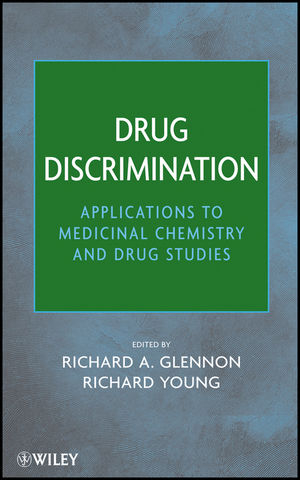
Drug Discrimination
John Wiley & Sons Inc (Verlag)
978-0-470-43352-2 (ISBN)
Drug discrimination: a practical guide to its contributions to the invention of new chemical entities and evaluations of new or known pharmacological agents
Drug discrimination can be described as a "drug detection" procedure that uses a pharmacologically active agent as the subjective stimulus. Although the procedure does require some effort to implement, it can be an extremely important tool for understanding drug action. Whereas medicinal chemists should come to learn the types of information that drug discrimination studies can offer, pharmacologists and psychologists might come to realize how medicinal chemists can apply the types of information that the paradigm routinely provides. Drug Discrimination: Applications to Medicinal Chemistry and Drug Studies provides in-depth analyses of the nature and use of drugs as discriminative stimuli and bridges some of the numerous gaps between medicinal chemistry, pharmacology, and psychology.
Stressing the practical aspects of drug discrimination, including types of procedures, study design, data, and interpretation, the book details the advantages and limitations of drug discrimination studies versus other pharmacologic evaluations. Practical information from leading researchers in the field addresses specific topics and techniques that are of interest in drug discovery, evaluation, and development.
A groundbreaking new guide to the applications of drug discrimination studies for medicinal chemistry and neuroscience, Drug Discrimination is essential for any scientist, researcher, or student whose interests involve the design, development, and/or action of drugs acting at the level of the central nervous system.
Richard Glennon is Chair of the Department of Medicinal Chemistry at Virginia Commonwealth University. He is the author of over four hundred scientific publications and book chapters. Richard Young is an Associate Professor in the Department of Medicinal Chemistry at Virginia Commonwealth University. Previously, he worked in the pharmaceutical industry at Ayerst and A. H. Robins (both now Pfizer).
Preface xv Contributors xix
Part I 1
Richard A. Glennon and Richard Young
1. An Introduction to Drug Discrimination 3
A. General Scope and Introductory Comments 3
B. Background and Utility of the Drug Discrimination Paradigm 7
C. Drug Discrimination: A Synopsis of the Approach 10
D. Drug Discrimination and Drugs of Abuse 11
E. Advantage of the Drug Discrimination Procedure 14
2. Methodological Considerations 19
A. Apparatus 19
B. Subjects 22
C. Operant Conditioning 23
3. Drug Discrimination: Practical Considerations 41
A. Drugs as Discriminative Stimuli 42
B. Choice of Dose and Pre-session Injection Interval 49
C. Discrimination Training Procedure 51
D. Discrimination Data 52
E. Testing 60
F. Data Analysis and Interpretations 78
G. Selected Topics 99
4. Role of Stereochemistry in Drug Discrimination Studies 129
A. Structural Isomers: Introduction 129
B. Constitutional Isomers 130
C. Stereoisomers 136
5. Drug Discrimination and in Vivo Structure-Activity Relationships 163
A. Structure-Activity Caveats 163
B. Phenylalkylamines Hallucinogens and Stimulants 165
C. Benzodiazepines 175
D. Neuronal Nicotinic Acetylcholinergic receptor Agents 177
E. Aminotetralins 178
6. Drug Discrimination and Mechanisms of Drug Action 183
A. Early Considerations 184
B. Classical Hallucinogens 186
C. Amphetamine-Related Stimulants 192
D. MDA and MDMA 198
E. PMMA 204
F. a-Ethyltryptamine 205
G. Anxiolytic Agents 206
7. Drug Discrimination and Development of Novel Agents and Pharmacological Tools 217
A. Applicability and General Comments 217
B. Novel 5-HT2 Serotonin Receptor Antagonists 218
C. 5-HT2 Serotonin Receptor Agonists and Radioligands 222
D. Aminotetralins as 5-HT1A Serotonin Receptor Ligands 225
E. Arylpiperazine 5-HT1A Serotonin Receptor Antagonists 225
F. MD-354 (meta-Chlorophenylguanidine): A 5-HT3 Serotonin Receptor Agonist 227
G. Loperamide and Risperidone: Clinical Successes 230
Appendix 235
Part II 239
8. Perceptual Drug Discriminative Aspects of the Endocannabinoid Signaling System in Animals and Man 241
Torbjörn U. C. Järbe
A. Introduction 242
B. Brief Synopsis of the Endocannabinoid Signaling System (ECS) 243
C. Cannabinoids/Cannabinergics and Drug Discrimination 244
D. Experimental Procedures and Species 244
E. Training Drugs 247
F. Procedural Considerations 253
G. Intended and Unintended “Bias” in Drug Discrimination 254
H. Origin of the Drug Stimulus and Sensory Mediation 254
I. Acquired Differences in Drug Sensitivity 255
J. Pharmacological Specificity 258
K. Phytocannabinoids and Metabolites 260
L. Endocannabinoid Ligands and the ECS 262
M. ECS Interactions with Other Signaling Systems 265
N. Conclusions/Summary 266
O. Addendum 268
9. Discriminative Stimulus Properties of Receptor Antagonists 287
Joseph H. Porter
A. Introduction 288
B. Adrenoceptor Antagonists 289
C. Antihistamines 292
D. Atypical Antipsychotic Drugs 294
E. Benzodiazepine Antagonists 299
F. Cannabinoid Antagonists 299
G. Cholinergic Antagonists 301
H. Dopamine Antagonists 302
I. GABAergic Antagonists 305
J. Opiate Antagonists 306
K. Serotonergic Anatagonists 310
L. Summary 312
10. The Discrimination of Drug Mixtures 323
Ian P. Stolerman
A. Introduction 324
B. Functional Models for the Discriminative Effects of Drug Mixtures 326
C. Initial Studies: Mixtures of Nicotine plus Midazolam 328
D. Characteristics of Diverse Drug Discriminations 329
E. Role of Training Doses 334
F. Variations in Functional Relationships: The Role of Training Paradigm 336
G. Antagonism of Mixture Cues and Training with Agonists plus Antagonists 342
H. Associative Processes 345
I. Investigations on the Ethanol Cue as a Compound Stimulus 348
J. Discussion 351
11. Making the Right Choice: Lessons from Drug Discrimination for Research on Drug Reinforcement and Drug Self-Administration 361
S. Stevens Negus and Matthew L. Banks
A. Operant Conditioning to Study the Stimulus Properties of Drugs 362
B. Choice Procedures in Studies of Drug Reinforcement: Lessons from Drug Discrimination 371
C. Summary 380
12. Inhalant Drug Discrimination Studies in Phesus Monkeys: Drug Dependence and Withdrawal 417
Jun-Xu Li, Lisa R. Gerak, and Charles P. France
A. Introduction 417
B. Some Factors Impacting the Discriminative Stimulus Effects of Drugs 418
C. Drug Interactions: Acute Dosing 420
D. Drug Interactions: Chronic Dosing 423
E. Summary and Conclusions 427
14. Human Drug Discrimination: Methodological Considerations and Application to Elucidating the Neuropharmacology of Amphetamines 431
Craig R. Rush, Andrea R. Vansickel, and William W. Stoops
A. Introduction 432
B. Methodological Issues to Consider when Designing and Conducting a Human Drug Discrimination Experiment 433
C. Using Human Drug Discrimination to Elucidate the Neuropharmacology of Amphetamines 444
D. The Future of Human Drug Discrimination 449
15. Nicotine Discrimination in Humans 463
Kenneth A. Perkins
A. Introduction 464
B. Basic Methods of Nicotine Discrimination Research in Humans 465
C. Basic Parameters of Nicotine Discrimination 468
D. Individual Differences and Moderators of Nicotine Discrimination 473
E. Conclusions 477
16. Drug Discrimination: A Perspective 483
The late Francis C. Colpaert
A. State Dependence and Drug Discrimination 484
B. Drug Discrimination in Receptor Pharmacology 484
C. Drug Discrimination and Subjective Drug Effects 485
D. New Concepts of Opiate Tolerance, Signal Processing, Pain, and Analgesia 486
E. Drug Discrimination: An Elementary Particle of Behavior and More 488
F. When Dependent Variables Chose Their Pharmacology 491
G. Two Further Mysteries 491
H. Epilogue 492
Index 497
| Verlagsort | New York |
|---|---|
| Sprache | englisch |
| Maße | 165 x 234 mm |
| Gewicht | 953 g |
| Themenwelt | Medizin / Pharmazie ► Medizinische Fachgebiete |
| Naturwissenschaften ► Biologie | |
| Naturwissenschaften ► Chemie | |
| ISBN-10 | 0-470-43352-3 / 0470433523 |
| ISBN-13 | 978-0-470-43352-2 / 9780470433522 |
| Zustand | Neuware |
| Haben Sie eine Frage zum Produkt? |
aus dem Bereich


